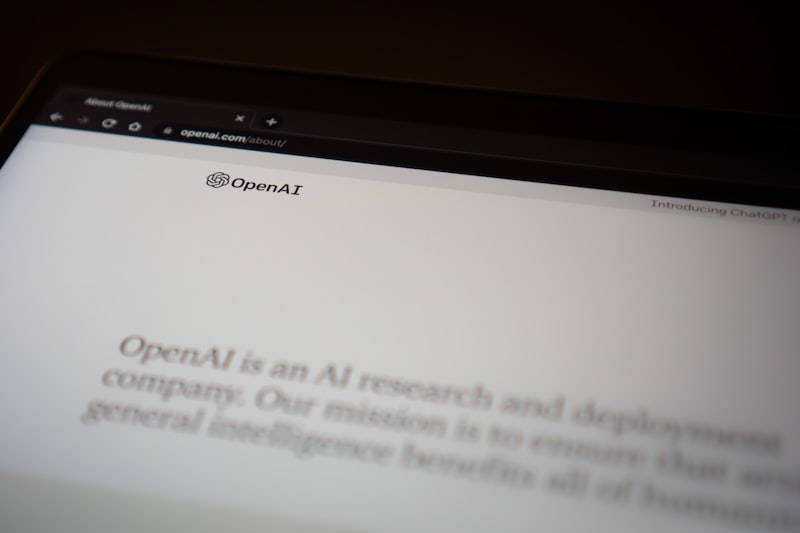Are you looking to explore the wonders of the ChatGPT API in Python? Look no further, as we delve into the exciting realm of using the ChatGPT API and unlock its potential. In this article, we’ll walk you through the steps and provide you with insights on how to effectively integrate ChatGPT into your Python projects.
Using the ChatGPT API with Python is a breeze. First, ensure you have a valid API key to authenticate your requests. With that in hand, you can begin by installing the OpenAI Python library, which provides an easy-to-use interface for interacting with the API. A simple “pip install openai” command will get you started.
Once you have the library installed, import it into your Python script. Then, utilizing your API key, create an instance of the ChatCompletion class. This class acts as your connection to the ChatGPT API, allowing you to send prompts and receive responses.
To generate a response, pass a prompt string to the openai.ChatCompletion.create() method, along with any additional parameters you wish to include. The prompt should be well-crafted, clearly conveying the context and objective of the conversation. You can guide the model’s behavior by including system-level instructions before each user message.
After sending the prompt, you’ll receive a response from the API containing the model’s generated message. Take care to extract the relevant information from the response object to seamlessly incorporate it into your application.
Remember that experimentation is key. Fine-tune your prompts and iterate to achieve desired results. Play around with temperature settings to control the output’s randomness, or use the max_tokens parameter to limit the length of the response.
As you harness the power of the ChatGPT API, keep in mind that it is designed to assist and augment human capabilities. Though it performs impressively, it’s important to review and validate its outputs, ensuring they align with your requirements.

The ChatGPT API opens up a world of possibilities for Python developers. By following these steps, you can seamlessly integrate the API into your projects, allowing you to create interactive and engaging conversational experiences. So why wait? Start using the ChatGPT API in Python today and witness the transformative power it brings to your applications.
Mastering ChatGPT API Python: A Step-by-Step Guide for Seamless Integration
Contents
- 1 Mastering ChatGPT API Python: A Step-by-Step Guide for Seamless Integration
- 2 Unleash the Power of ChatGPT API Python: Unlocking Limitless Conversational Possibilities
- 3 Boost Your Productivity with ChatGPT API Python: Tips and Tricks for Efficient Implementation
- 4 From Novice to Expert: Navigating the ChatGPT API Python Documentation Like a Pro
Are you ready to unlock the full potential of ChatGPT API Python? In this step-by-step guide, we’ll delve into the art of mastering ChatGPT’s API and show you how to seamlessly integrate it into your projects. Get ready to take your conversational AI skills to the next level!
First things first, what exactly is ChatGPT API Python? It’s an interface that allows developers to harness the power of ChatGPT in their own applications. With just a few lines of code, you can tap into the vast knowledge and language generation capabilities of ChatGPT. It’s like having your very own AI assistant at your fingertips!
To get started, you’ll need to set up your development environment. Make sure you have Python installed on your machine, preferably the latest version. Once that’s done, you can install the OpenAI Python library using pip, which is a package manager for Python. Simply run the command ‘pip install openai’ in your terminal, and you’re good to go.
Next, you’ll need an API key from OpenAI. This key will grant you access to the ChatGPT API. Head over to the OpenAI website, create an account if you haven’t already, and generate your API key. It’s a straightforward process that will only take a few minutes.
With your API key in hand, you’re ready to dive into the world of ChatGPT integration. Start by importing the OpenAI library in your Python script. Then, initialize the library with your API key. Now, you can begin crafting your requests to ChatGPT.
Remember, the key to a seamless integration is formulating clear and concise prompts. Think of prompts as the questions or statements you make to ChatGPT. The better you frame your prompt, the more accurate and relevant the response will be. Experiment with different phrasings and approaches to find what works best for your specific use case.
Once you have your prompt ready, make a call to the ChatGPT API using the openai.ChatCompletion.create() method. Pass in your prompt as the messages parameter, and watch as ChatGPT works its magic. The response will contain the AI-generated message, which you can extract and utilize in your application.
That’s it! You’ve successfully mastered ChatGPT API Python integration. With this newfound knowledge, you can create dynamic chatbots, interactive games, or even enhance customer support systems. The possibilities are endless.
So, go ahead and take the plunge into the world of ChatGPT API Python. Unleash your creativity, and let the power of natural language processing transform your projects. Happy coding!
Unleash the Power of ChatGPT API Python: Unlocking Limitless Conversational Possibilities
Are you ready to unlock a world of limitless conversational possibilities? Look no further than the ChatGPT API Python! This powerful tool empowers developers to tap into the immense potential of OpenAI’s language model, enabling seamless integration of natural language processing capabilities into their own applications.
With the ChatGPT API Python, you can create chatbots, virtual assistants, customer support systems, and more. The possibilities are truly endless. Whether you’re building a smart home device that understands voice commands or a language translation app, this API has got you covered.

What makes the ChatGPT API Python so remarkable is its ability to comprehend and generate human-like text. It utilizes state-of-the-art deep learning techniques to understand context, respond intelligently, and carry on meaningful conversations. By leveraging the power of GPT-3, you can deliver an exceptional user experience that feels like interacting with a real person.
Implementing the ChatGPT API Python is a breeze. With just a few lines of code, you can send a series of messages to the API and receive well-crafted responses in return. It’s like having a knowledgeable assistant at your fingertips, ready to assist users with their queries, provide information, and engage in engaging dialogue.
Imagine the impact you can make by integrating this technology into your application. You can revolutionize customer interactions, enhance user engagement, and streamline complex processes. Instead of navigating through menus and forms, users can simply talk or type naturally, receiving accurate and prompt responses.
To unleash the full potential of the ChatGPT API Python, creativity is key. Think of all the ways you can utilize this tool to enhance existing applications or build entirely new ones. The only limits are those of your imagination.
So, why wait? Dive into the world of conversational AI with the ChatGPT API Python and discover the incredible opportunities it brings. Revolutionize the way people interact with technology, empower your applications with natural language understanding, and unlock a future where seamless conversations are just a few lines of code away.
Boost Your Productivity with ChatGPT API Python: Tips and Tricks for Efficient Implementation
Are you looking for ways to enhance your productivity and streamline your workflow? Look no further! With the powerful ChatGPT API in Python, you can take your projects to the next level. In this article, we will explore some valuable tips and tricks to help you make the most of the ChatGPT API and achieve efficient implementation.
-
Harness the Power of Conversational AI:
ChatGPT API Python allows you to integrate conversational AI capabilities into your applications effortlessly. By leveraging the API’s natural language processing abilities, you can create chatbots, virtual assistants, or even automate customer support systems, saving you time and resources. -
Designing Engaging Conversations:
To captivate your users, it’s crucial to create engaging conversations. Craft personalized greetings, use an informal tone, and employ rhetorical questions to make the experience more interactive. Remember, users are more likely to stay engaged when they feel like they’re talking to a real person. -
Context Retention for Smooth Interactions:
Maintaining context during conversations is vital for seamless interactions. Ensure that you provide relevant information throughout the dialogue to avoid confusion. The ChatGPT API Python enables you to store and manage context, allowing you to build coherent and meaningful conversations. 
Implement Effective Error Handling:
Handling errors gracefully is essential when working with any API. Anticipate potential errors, such as invalid user inputs or timeouts, and include error handling mechanisms in your code. By doing so, you can improve the reliability and stability of your application.-
Experiment with System Messages:
System messages allow you to guide the conversation and set expectations for your users. They can be used to provide instructions, suggestions, or clarify the purpose of the interaction. Utilize system messages strategically to improve user experience and steer the conversation in the right direction. -
Iterate and Refine:
Building powerful conversational AI models takes iteration and refinement. Experiment with different approaches, collect user feedback, and continuously fine-tune your implementation. This iterative process will help you create more effective and user-friendly applications over time.
Integrating the ChatGPT API Python in your projects can revolutionize your productivity by leveraging the power of conversational AI. By implementing these tips and tricks, you can create engaging conversations, retain context, handle errors effectively, and design highly efficient applications. Don’t wait any longer—start exploring the endless possibilities of ChatGPT API Python today!
Are you ready to level up your skills and become an expert in navigating the ChatGPT API Python documentation? Look no further! In this article, we’ll guide you through the process, providing valuable insights and tips to help you master the art of working with the ChatGPT API like a pro.
When diving into the ChatGPT API Python documentation for the first time, it’s natural to feel a bit overwhelmed. But fear not! We’re here to demystify the process and make it a breeze for you. The documentation serves as your trusty map, guiding you through the intricate world of ChatGPT API integration.
To start your journey, familiarize yourself with the basics. Learn about the various endpoints available, such as message-based and completion-based methods. Understand how to structure your API requests and interpret the responses effectively. With this foundation, you’ll be equipped to harness the true power of ChatGPT.
As you delve deeper, don’t shy away from examples and code snippets provided in the documentation. They are your secret weapons! Study them meticulously and comprehend their underlying logic. By doing so, you’ll gain clarity on how to implement different functionalities and tailor them to suit your specific use cases.
Remember, practice makes perfect. As you progress from novice to expert, actively experiment with the API in your own projects. Embrace the trial-and-error process, as it will sharpen your understanding and unveil new possibilities. Additionally, leverage online developer communities and support channels to seek guidance and learn from fellow developers who have embarked on a similar journey.
Think of the ChatGPT API Python documentation as a treasure trove of knowledge, waiting for you to unlock its secrets. Each paragraph you read and comprehend is like discovering a precious gem that enhances your prowess. So, dive in headfirst, explore the depths, and emerge as a seasoned explorer of the ChatGPT API realm.
Mastering the ChatGPT API Python documentation is an exhilarating adventure. By immersing yourself in its intricacies, experimenting with code, and seeking guidance when needed, you’ll transform from a novice into an expert navigator. So, grab your compass (or rather, your keyboard) and embark on this exciting journey to unlock the limitless potential of ChatGPT API integration. Happy exploring!




